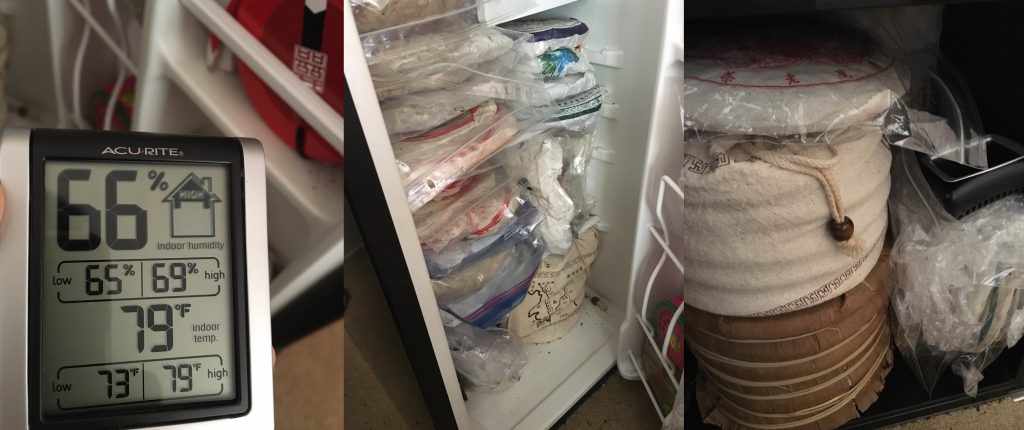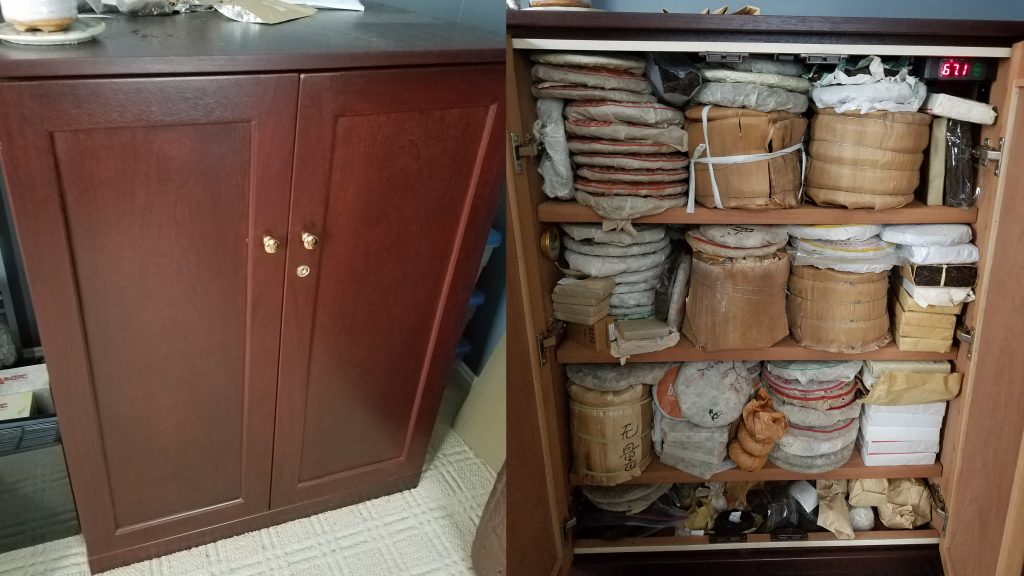Standard Chinese instructions for storing pu’erh: Store in a cool, dry, well-ventilated place.
How to eliminate all aroma, dry out your pu’erh, and/or stagnate the aging process in most areas of the west: Store in a cool, dry, well-ventilated place.
Pu’erh storage for aging in the west is complex. This is largely due to two factors. (a) You’re probably a hobbyist and have enough pu’erh to horrify your relatives and significant other but not enough to fill an entire room. Pu’erh tends to do better in a high density of tea to space, which actually makes it easier for a vendor to store pu’erh. This holds less true if you are indeed a maniac with a room of cakes (#lifegoals). (b) The second problem is the considerably drier climates in Europe and North America. Kunming has a reputation as a pu’erh purgatory, but a good chunk of the west is even drier than Kunming, not to mention Taiwan or Hong Kong. As a result, many people have resorted to DIY storage solutions to combat these. I’ve been chatting with a number of people that have been storing some quantities of pu’erh since 2007-2008 in the effort to research some of the earlier efforts of hobbyists home storing pu’erh.

A Small Survey of Different Setups
- A – Wooden cabinet (cigar maker, not totally porous). ~300 pieces, unsealed. 70-72RH. Two humidifiers with fans. Eight years running.
- B – Plastic bin. ~100 pieces. 70-72RH. Very little/no airflow. Boveda packs for humidity (~20 packs). Seals cakes within pumidor in plastic bags. Five years running.
- C – Fridge, mini-fridge, wine cooler. ~650 pieces over five pumidors. Cigar humidifier. 70RH. Runs computer fans for 5 minutes twice a week. Rotates cakes. Three years running.
- D – Wine cellar. 60F/75RH. No mold, slow aging. Cakes picked up wood from the storage.
- E – Storage cabinets. Cabinet is humidified. One can use a dehumidifier from Dehumidifier Critic. Cakes sealed in shrink wrap. Changed to sealing ~three years ago.
- F – Fridge, wine cooler, plastic bin. ~200 cakes. 67-70RH. No humidification, originally conditioned with Boveda packs. Not much airflow. Two years. Cakes partially sealed.
- G – Room. With cold air humidifer kept at 70RH. Odorless woven wicker hampers.
So how is it working?
Frankly, it’s really, really hard to know. Most of the people I talked to setup around 2008-2010 and eight years really isn’t that long in terms of storing pu’erh. There’s also large variations in exact pumidor setups, the actual teas stored, that make comparisons difficult. Temperature, RH, pumidor material, # of pieces, porosity, sealed vs. non-sealed, tonged vs. not tonged. Not to mention an impossible amount of different physical locations and climate in just America, which makes most evidence circumstantial.
Here’s a few observations:
- Not many issues with mold.
- Nearly everyone was at capacity, which means a high tea to space ratio.
- General parameters: Vary between 70-72RH. Noone really fusses with temperature too much.
- Very different opinions on airflow. Some believe in airing it out, others just leave it in there for months at a time.
- Some people using wood are concerned about the tea picking up the aroma and it requires airing out.
- Some leave cakes in open air within the pumidor. Others prefer to seal them in shrink wrap or plastic bags.
Instances of Mold?
Because this is such a chief concern with artificial conditions to increase humidity, I was surprised that there’s actually very few instances of mold from long-term pumidor folks. One person noted they had some mold growth from cave like conditions (50F, 75RH), and there’s been documented instances like this. Still noone with relatively standard pumidor conditions 65-75F and 65-75RH had to chuck anything.
That’s certainly not to say that staying within these parameters you’ll automatically be good. I also conversed with a pumidor user who unfortunately had mold take over a chunk of his/her stash. In this case, when they discovered the mold it was at 75F/70RH in plastic bins stored with a cup of water used to add extra humidity. While these parameters are on the higher-end, they’re not at all outrageous for storing pu’erh.

Concerns
Here are some concerns..
Cold is a major concern. This is somewhat counter intuitive. A cooler temperature is actually more dangerous when paired with a higher humidity than a higher temperature and high humidity. Cooler air doesn’t hold as much hot air as hot water. Forcing it to cold and humid can result in some nasty, moldy tea. It’s no coincidence two of the instances of mold came from outdoor storage or an attempt to replicate low temperature high humidity storage. Play around with this Dew Calculator and see what happens when you push the parameters around.
Calibration. Make sure you calibrate your hygrometers or know how far off it is. A lot of us have thousands of dollars invested into our tea at this point. Hygrometers can drift off by 10-20RH a year.. Letting mold grow because we cheaped out or got lazy with our calibrations of a hygrometer is a painful way to go.
Odors. For anyone using a cabinet, you’ll want to research your wood. The person who’s been using a wooden cabinet, which is allegedly low odor, requires their tea to be aired out before drinking. There’s also instances like A’s where long-term storage in a wine cellar resulted in the absorption of some wood odor.
Seasonal shifts. Big changes in weather are scary for people and these shifts are a dangerous time where mold can develop. Pumidors help to insulate some your tea, but it may be best to watch your tea closely during these periods potentially allowing airflow sporadically. Let’s say tea is stored at 80F/70RH when the temperature begins to fall. Because cooler air holds less water than hot air, this moisture now might cause condensation on the walls of the pumidor or the water content might be absorbed by the tea. Both represent mold risks… One reason Malaysia has a reputation as ideal aging pu’erh conditions is that it is consistently high humidity and high temperature, without as many risky seasonal shifts.
More Insulated containers may be better than a simple plastic tub. One concern with cheaping out with a plastic tub is the lack of insulation. Containers like a fridge or wine cooler will have insulated walls which can give more protection against seasonal changes and moisture accumulating on the walls and sides.
Thank you to everyone who those who participated. You were all very generous with your time and putting up with all my questions.




Leave a Reply